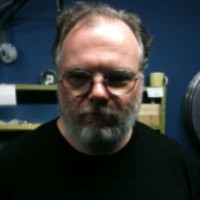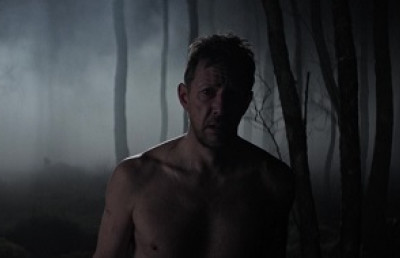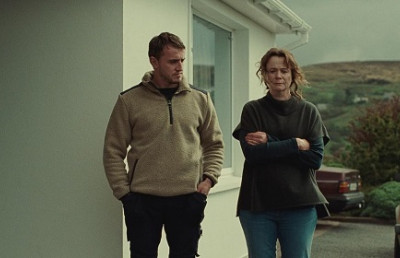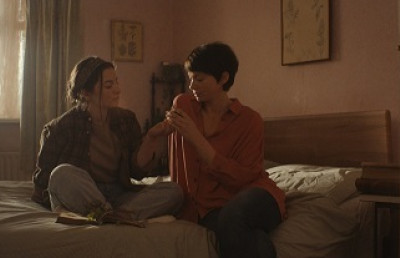A Conversation with Independent Filmmaker Chiara Viale
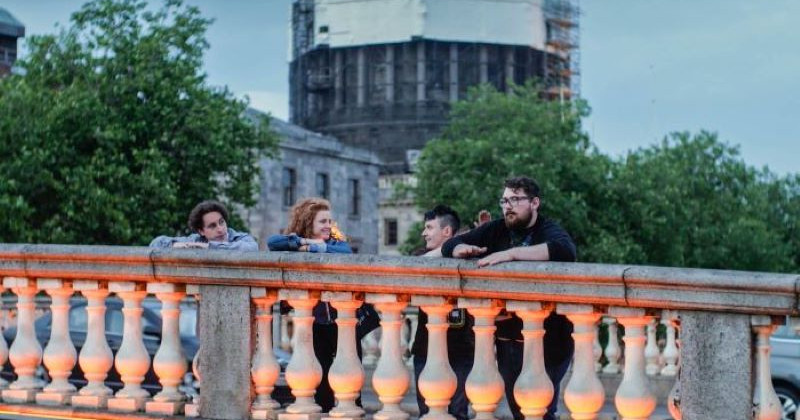
The New Music (Production Still, photo source Chiara Viale)
Chiara Viale is an Italian-born writer-director based in Dublin, Ireland, where she has lived since 2015. She has directed four short films: Be Frank (2017), Clown (2018), The Plait (2020), and Learning Curve (2022). Her first feature-length film, The New Music, was released in 2019, and has been on the festival circuit ever since, where it has impressed audiences with its freshness, energy, killer soundtrack, and strong visual quality. This e-mail interview was conducted August 24, 2023.
Offscreen (OS): Where did The New Music come from? Can you talk about how this project developed?
Chiara Viale (CV): Music plays a fundamental role in my creative process. From a young age, stories and characters have come to me through music and to this day it remains my main source of inspiration. The initial concept occurred to me in 2016 when I started to listen to Fugazi and came across the song “Blueprint.” As the track played, I found myself visualizing a musician who could not play anymore and did not know how to communicate this to his band members. Following this premise, I wrote a short film script entitled The Pianist and the Punks. The script was very much inspired by my experience of playing in a band in my twenties and my love for punk music.
Doing my research for the script I looked into which condition would cause Adrian, the protagonist, to lose his ability to play the piano. This is when I discovered the existence of Young Onset Parkinson’s and decided to develop the story in this direction. The project remained a short script until early 2017, when the Dublin Filmmakers Collective launched a feature film challenge. The challenge entailed pitching, crewing, shooting, and delivering a feature film within a year. In order to participate in this challenge, I chose to revisit The Pianist and the Punks and expand it into a feature. The finished script became The New Music.
OS: Why did you choose this material (or did it choose you?) to make your debut as director?
CV: By 2017, I had been part of the Dublin Filmmakers Collective, one of the few groups of its kind in Ireland, for over a year. The Dublin Filmmakers Collective was created to encourage and support filmmakers to come together and make films. Meetings welcomed everyone regardless of previous experience and people shared talent, resources, and expertise with each other. It was there that I made my first steps into screenwriting in English, directed my first short films, and joined the filmmaking community in Dublin.
One of the most important aspects of making films this way is to be ready to work within a limited budget. This is the main reason why, when the Dublin Filmmakers Collective launched their feature film challenge in 2017, I chose not to pitch any of the feature screenplays I had written to date, but instead expand on The Pianist and the Punks. This script had the right characteristics to be developed into a low budget feature and adapted to the many variables we would encounter along the way. I started directing my own films in 2016 and I was still very new to this craft, but I was eager to learn and wanted to challenge myself. I had begun to realize that the visual clarity I always had writing my stories was not just a trivial side effect of making up stories in my head. I started to trust my vision, work with actors and cinematographers, and study how to translate my imagination into the language of film.
When the challenge came along, I was supported and encouraged to direct The New Music. I owe so much to everyone involved in the film for the immense trust they put into my vision and for enabling me to take this gigantic step forward as a filmmaker.
OS: Among other things, this is a film about Parkinson’s. Do you feel a particular kinship to the material?
CV: When the story originally took shape, I was not aware of Young Onset Parkinson’s. Like the vast majority of people, I thought of it as an old person’s disease. While researching the condition afflicting my protagonist, I came across the section of the Parkinson’s Ireland website dedicated to Young Onset, which came with the word “rare,” and something just clicked. My father passed away in 2013 with Multiple System Atrophy, a rare neurological condition for which there is no known cure. As I was confronted with Young Onset Parkinson’s for the first time, I was overwhelmed by a number of feelings and I was taken back to the years of his illness, when the term “rare” meant lack of knowledge, sometimes lack of care, sometimes lack of understanding, but most of all loneliness. To this day, I am deeply grateful to the UK MSA Trust for sending its publication all the way to Italy for me to translate to my father. Us going through the symptoms together and reading of other people’s life stories had been one of our last chances of closeness before his passing. I suppose this explains why after reading the word “rare,” I instantly knew I needed to look no further. I felt I could write a story to help shine a light on another rare condition that I, for one, was ignorant of. I had a strong sense that what became The New Music could be my humble chance to return, albeit in a different form, the help me and my father were given.
OS: Is there a special responsibility that comes with taking on such a weighty topic?
CV: From my perspective, the biggest responsibility was to be unconditionally truthful, to refuse any artifice or device that could make the film perhaps more commercially appealing, but incorrect in my depiction of the experience of those living with Young Onset Parkinson’s. Although the feature script took shape quickly, I waited until a contact was established with Young Parkinson’s Ireland and the script was approved by their members before moving production further. In the spring prior to filming, I met with the charity to discuss the script, ask questions, and hear their thoughts. Young Parkinson’s Ireland’s reception of the script and the project was overwhelmingly positive and encouraging, and only then did I feel the material was ready for filming. A similar process was undertaken after principal photography, when we shared the rough cut with Young Parkinson’s Ireland to take in their point of view and feedback. This relationship continued until final cut and to this day they are very much involved in the film’s journey through Early Onset Parkinson’s Ireland (EOPD.ie).
OS: Was there a worry that the seriousness will drag down the humour and romance also in the film?
CV: From the very origin of The New Music, the Parkinson’s, punk, and friendship elements of the story have been closely intertwined. The romance that takes place in the film is completely dependent on Adrian’s process of embracing his reality. No true love story or friendship is possible without acceptance. Within the film, the protagonist finds out that his biggest challenge is not the acceptance of others, but of his own self.
Throughout the making of the film, I was never worried about being too serious. All I was concerned with was the humanity and truthfulness of each scene and I very much trusted that the light-hearted and dramatic aspects of the story would balance each other out. Furthermore, most of the humour in the film was generated together with the actors and by the actors themselves. The cast truly took the story on board and contributed to it coming to life in a natural and authentic way.
OS: Can you talk about the visual style your producer-cinematographer Philip Kidd was going for? How does the collaboration between the two of you work when designing and creating the film’s look?
CV: Philip is a wonderfully creative, resourceful, resilient, and focused cinematographer. His input gave the film a depth and significance that went well above and beyond my own imagination. The New Music was shot-listed and filmed with a constant eye on its low budget, yet Philip always found the most creative solutions to elevate each shot, to extract the best from each location, and to enhance the emotional impact of each scene to its highest extent. An example of this are the sequences filmed in the kitchen of the shared apartment. A lot of the film takes place in this one room and Philip planned to shoot each scene differently, so that the space would never feel constricted, but have a feeling of freshness every time the story returned to the same location.
Philip and I worked closely in pre-production to iron out every detail, discussed all visual aspects, and ensured we were exactly on the same page before production began. Having established such a close collaboration meant that on set we moved as one, we shared the same vision, and there was complete trust in each other’s work.
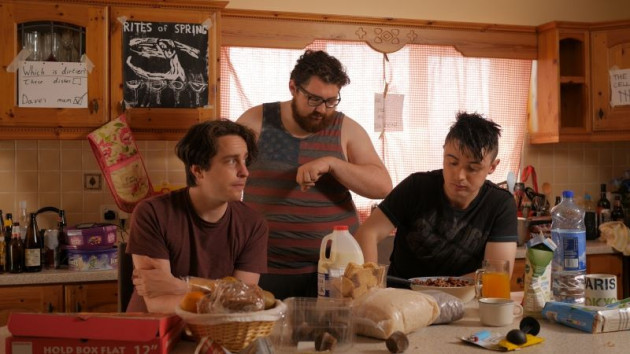
Adrian (Cilléin McEvoy), Will (Jack Fenton), and David (Patrick O’Brien) have breakfast (photo source, Chiara Viale)
OS: Did you have a specific idea of how you want the film to look when you were writing the script, or did this come in collaboration with Philip?
CV: The New Music fully took shape in my head at script stage. So did the exact pacing of most music sequences and the feeling that each scene would communicate visually. With each of my projects, I tend to finish writing with the complete film already formed in my imagination, however, paraphrasing Robert Bresson, a film is destined to die on the paper and be born again on set. This is particularly true in the case of this project, as most of the locations where I visualised the story taking place were not available at the time of filming. Our shot list was used as a guide, but it remained subject to change and we came on set constantly ready to adjust, amend, and work around any unexpected constraints. This proved challenging, but also creatively stimulating and it contributed to the film’s originality. The New Music revolves around truthfulness, imperfection, and the courage to step into the unknown. I believe this meaning seeps through each aspect of the film, from its story to its visual style, from script to screen.
OS: At what point in the process do you make decisions about music, editing, visual style, performance, etc.: when you’re writing, when you’re rehearsing (assuming you have the time or money to rehearse), or spontaneously when you’re shooting?
CV: One of the reasons why I am in love with cinema is that it is a collaborative art form. What ends up on the screen is the result of the craft and creativity of many people who come together to bring it to life. I may very early have a clear idea of the film I want to make, but a lot of decisions are the result of collaboration. This is crucial with regards to performance, where I consider the actors’ input fundamental to find the ultimate truth of each character, but also in all other aspects of filmmaking.
I definitely try to make any decision as early as possible to create the most solid base I can for the film to stand on, but I am also open to be surprised, to be faced with the unexpected and to make a last minute decision that might bring more authenticity to the story, more resonance to the edit, more depth to a performance.
OS: For this kind of film to work, the music has to be credible, that is, the audience has to believe the music is good enough to have been created by talented musicians. So who wrote the music and where did you find them?
CV: The two original punk songs were written by Dublin musician Zachary Stephenson. I was put in touch with Zach by Philip while in pre-production and I briefly explained to him what kind of feeling I was looking for in each song. The Cellmates’ performance of “Hide” and “Home” are crucial moments in the film. The song “Hide” was meant to be a revelation, almost a shock. It represents that moment when a song written by a stranger feels exactly as if it was meant for you to hear. Zach’s lyrics “all that I have left/ is to look deeper inside/ and find another place to hide” are sung by the character Will, someone who up to that point in the story was shown to be cheerful and humorous. They tell us that there’s more to him than we think and that music is an outlet for him to express a different side of himself. Of course, when Adrian hears these words, they feel as if they’re about him. He feels pushed out of his comfort zone and his conflict is exposed. “Home” is a song of triumph. The song is composed by the band throughout the film and it comes together only once Adrian joins in as keyboardist. It represents life moving forward.
When Zach sent me the demo versions of the songs, I was so moved I started to cry. I had given him a few bands for reference, done my best to communicate what I needed, but he went above and beyond my expectations. The two tracks truly hold the film together and I am privileged to have had the opportunity to have had Zach on board.
Most of the original piano music was written and performed by David Sangster, a pianist from the UK with Young Onset Parkinson’s. David got in touch with me in 2018 when the film was in post-production and offered his help. At the time I still didn’t have the final classical tracks for the film and I enthusiastically accepted his offer. Working with David has been one of my most life-changing experiences. Not only did he gift us incredible music, but he brought the film to an entirely new level with his passion, dedication, and support which continues to this day. Adrian’s piano performance towards the end of the film is again a fundamental moment. Similar to the punk songs in the soundtrack, it propels the story forward and carries the audience into the heart of the characters. David’s performance of “Una Vita” is the moment when Adrian embraces himself completely, all the music he made to that point and all the music he will make from now on, no matter what.
Additional music was written and performed by the sound designer Fernando Chapa, whose work permeates the film. An example of his wonderful contribution is the piano score during Adrian’s flashback sequence halfway through the film, a composition that really brings the audience straight into the protagonist’s memories, an emotional rollercoaster into Adrian’s inner world, a window into the past he is trying so hard to run away from.
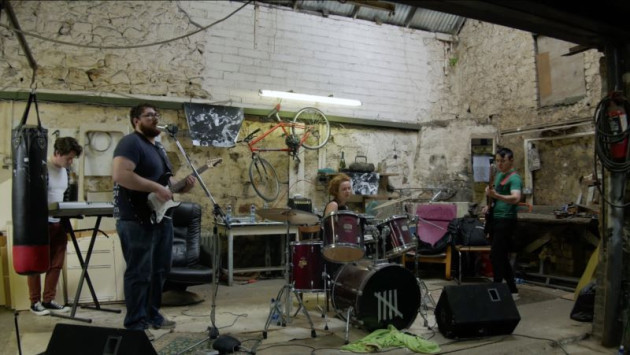
A movie band that sounds like a real band – The Cellmates rehearse: Adrian (Cilléin McEvoy), Will (Jack Fenton), Jodie (Martina Babišová), David (Patrick O’Brien) (photo source, Chiara Viale)
OS: Did you have specific music in mind when creating the story?
CV: Aside from the original music already mentioned, I wished to fill the film with music, with songs that the band would listen to, music that would carry the audience from a scene to the next, music to celebrate the old and new life of the protagonist. While writing I listened to a lot of punk bands and I created a wish list ahead of filming. Once in post-production, we contacted a number of local and international bands. The final soundtrack includes incredible artists such as Billy Liar, Antillectual, Shit Present, Bangers, Checkpoint, and many more. This fantastic music is the spinal cord of The New Music and I am hugely grateful for these artists to have come onboard. They truly made all the difference.
OS: There is a lot of music in the film. Was there ever a point where you were worried there might be too much music, that it gets in the way of the story?
CV: Looking back, there are instances where I wish The New Music had a few additional scenes and to have had the opportunity to expand the story a little further. With regards to music however, I think each song we have there belongs in the film and contributes to making it what it is. As musicians themselves, the characters are obsessed with listening to music all the time. It is the centre of their world and the film’s soundtrack reflects their lifestyle and perception of reality.
OS: Did you think about how much space you needed between performance sequences?
CV: A very important aspect of the film was to show the songwriting process. The song “Home” is actively rehearsed throughout the story. As the band is ready to perform it for the first time they are interrupted, but “Home” is then fully played at the end of the film. This final performance exemplifies the triumph of coming back to ourselves, of embracing our imperfections and celebrating life. The decision of when each performance would take place was made at script stage, as those scenes are decisive turning points in the narrative. However, the final timing between them and how they would flow into each other was confirmed in the editing room.
OS: Can you talk about the specific artists from the punk scene you referenced in the film, what about them interests you, and indeed what draws you to punk in general, and why you chose that genre of music for the film?
CV: I started to listen to punk music only in the last few years. I previously had a general knowledge of the genre, but I never felt it was right for me. When I moved to Ireland in 2015, however, I was introduced to punk through bands such as The Menzingers, Shit Present, The Flatliners, Captain We’re Sinking, Onsind, and Off With Their Heads, to name a few. My first reaction to this type of punk was basically one of shock (not entirely different than Adrian’s). I was disarmed by the honesty, truthfulness, and rawness of these bands. I was presented with artists who are fiercely unapologetic about their emotions, who dare to sing (and sometimes shout) at the world who they truly are, what they truly feel, regardless of any conception of perfect music, perfect singing, perfect looks.
In all honesty that was the moment I realized I had been artistically a coward my whole life. I remember watching a video of Chris T-T performing “Ankles” on Santa Barbara beach and thinking: “what’s my excuse now?” The truth is that until that first encounter with punk, I had been too terrified to share my best writing and seriously try to become a filmmaker. I used to give myself all sorts of explanations such as “it’s too much,” “it’s too dark,” “who are you to impose your emotions on others?”, “you’re just showing off,” and so on and so forth. I suppose you can see where this is going! After listening to these bands and watching their videos I felt none of my excuses had any ground to stand on. I clearly remember thinking: “if they can do it, I can do it”. So, in a way punk is what set me off on my filmmaking career. It gave me the courage to take those scripts out of the drawer and put them in people’s hands, it gave me the fierceness to walk on a film set and know that yes, I would not be perfect, but I did have something to say.
From the moment when the first creative sparkle presented itself to me, the film has been inspired by, written with, and envisioned surrounded by this type of punk music. For me, punk is the music of raw expression and of bold creative imperfection. It is also the music of rebelling and fighting. It is the music of change. I feel no genre better than punk can describe Adrian’s journey from a paved, safe road into the wilderness and unpredictability of a whole new life. The ethos of punk, its inclusivity and boldness, embodies to perfection what The New Music is all about, both on and off the silver screen.
OS: Can you also talk about the contrast you provide between punk and classical, which many would assume is as extreme a difference as is possible, and the fact that your lead character bridges the gap?
CV: Although I don’t really play an instrument, I always perceived classical music as a world of discipline. The classical musicians I know are completely dedicated to their instruments and stories of obsession, sacrifice, and misunderstood genius permeate classical music. At the origin of the concept of the story is a young man who dedicated his whole life to playing music, someone who has talent to back his practice, a young genius who already lives in a world of tuxedos, concert halls, and elegant circles. In the film, classical music is the metaphor of the straight path, of the linear cause-leads-to-effect: playing extraordinarily means recognition and acceptance, all is well as long as one can perform. This is also a metaphor of what we tend to call “normality.” Everything is okay as long as we are able to look and behave according to society’s expectations. If this balance breaks, if our performance is interrupted with no chance of resumption, the world falls apart. Punk music is obviously antithetical to this concept. It represents creative chaos and embodies the fragile, unpredictable, unbalanced life that awaits Adrian after his diagnosis. For him, nothing will ever be a straight line ever again. The choice of juxtaposing classical music with punk comes from wishing to restore the fracture between what was and what will be. Adrian will never play as he used to, so at the beginning of the film he refuses to do so altogether and goes as far as pretending he never has. The sequence in the music shop in particular shows the agony of this process, the pain of Adrian in not permitting himself to experience his love for music anymore while longing for it with all his being. This is why punk music is particularly important for Adrian’s process, it teaches him that who he is right now is enough, that what he has to offer to the world still exists. That his life is much more than a performance. In the film Adrian has to accept change and discover a new way to make music but, in this process, he won’t be alone: by opening up and accepting help Adrian finds his band, his tribe, those who will be there for him no matter what life has in store.
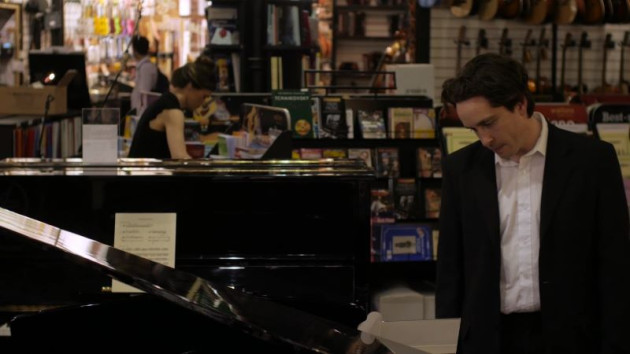
Adrian (Cilléin McEvoy) at the piano store. (photo source, Chiara Viale)
OS: Your lead actor, Cilléin McEvoy, was very good in a potentially tricky part, playing someone with Parkinson’s disease. What kind of preparation did he bring to the part and to what extent was it a collaboration between you? That is, did you give him much direction or did he know what he was going to do when you started filming?
CV: Cilléin was attached from the very start. I had experience directing him and I knew I could unconditionally trust him with the character and with the process necessary to bring him to the screen. Cilléin is an extremely dedicated actor and he immediately understood the depth and responsibility of playing Adrian. I felt perfectly comfortable in leaving him in charge of preparing for the role knowing he would come to me for anything he needed. Cilléin prepared himself by consulting and studying materials from the Michael J. Fox foundation and other sources of Parkinson’s Awareness. We subsequently broke down the script together and had lengthy conversations on how to visually communicate Adrian’s states of mind, his physical struggles, and his emotional process. Most of the work Cilléin did is “between the lines.” His performance is made of countless little details which are just hinted to the audience. For most of the film, Adrian’s main objective is to hide his condition and this bottled up tension, pain, and, at times, self-loathing accompany him in every waking moment.
By the time we started filming, every detail had been discussed and ironed out, however space was left for experimenting in the moment and for finding additional truth and emotion within the scenes. Communication was always open between us on set. He knew what I was looking for and I knew he was ready to go all the way to bring Adrian to life.
OS: Do you create your characters with specific actors in mind? What does the individual actor bring to a project? Did a character change during the rehearsal and filming process because of the actor’s input?
CV: I tend to create my stories with “placeholder” actors who can be the very cast I wish to approach with the script upon completion, but sometimes they are musicians or even friends and family. This helps me shape the narrative in a very concrete way and to visualize the film as I write. It also gives me tangible references to create characters who are as real to me as my own friends.
In this case, I wrote the character of Adrian specifically for Cilléin, as he was involved in the project from the beginning. I also had a very clear idea of the personality and look I needed for the characters of Will, Jodie, and David. The rest of the cast took shape as the story progressed.
The characters I write don’t tend to change through casting as their personality and emotional world comes to life way before the actors are attached. However, the cast contributes to the role with their individuality and talent, so I feel that my work with them is similar to adjusting a garment to a person’s exact measurements. The clothes are perfect on the hanger, but now that they’re on a real person they need a bit of extra fitting.

Adrian (Cilléin McEvoy) at the piano (photo source, Chiara Viale)
OS: Did the actors have any input into the screenplay, either beforehand or through improvisation, or did they keep to the script?
CV: I absolutely love the process of enriching characters by discussing them with the cast and I consider readings and rehearsals fundamental before filming. Particular attention was put into casting The Cellmates, and we expanded and fine-tuned the dialogue together. This was vital to ensure that Jack Fenton [Will], Martina Babišová [Jodie], and Patrick O’Brien [David] would feel like a real band. They had to sound like friends, like they’ve known each other and played together for a very long time. Each of their lines had to sound their own. This meant a few changes, but mostly a flexibility in diction and choice of words. I made sure to stress that I wanted them to feel comfortable and at ease with their lines. If a word didn’t seem like something they would say, I was happy to see it go.
There were a number of changes to the script based on the actors’ input. Perhaps the major one is Will’s monologue, where he explains to Adrian what is basically the meaning of the film itself: “We are not perfect, right? Life isn’t perfect. Nothing’s perfect.” On the second day of filming, Jack came to me with something he had thought to add to one of his lines. It didn’t suit the scene we were shooting that day, but I knew it belonged in the film so I added it later in the script. These extra words ended up in Will’s monologue and the contribution they made to the film doesn’t need any explanation.
Another very important change that comes to mind is the scene before The Cellmates’ first gig with Adrian, when he confides his fears to Jodie. At the end of the scene, the characters were supposed to kiss, but Martina asked me if instead she could just stay close to him. This resulted in a beautifully intimate moment where Jodie takes Adrian’s hand. That gesture means everything and again it conveys the meaning of the film itself.
The actors’ input has been vast. It even includes wardrobe, as the production did not have the resources for costumes and each actor wore what they thought would fit their character. A fun fact is that it was Patrick O’Brien’s own decision to wear a mohawk. He felt that hairstyle would suit the character of David and he went off to shave his sides.
As you can imagine, I can’t put into words what each of these things meant to me and to the film. These were the actor’s own gifts to The New Music, and the film would have never been what it was without them.
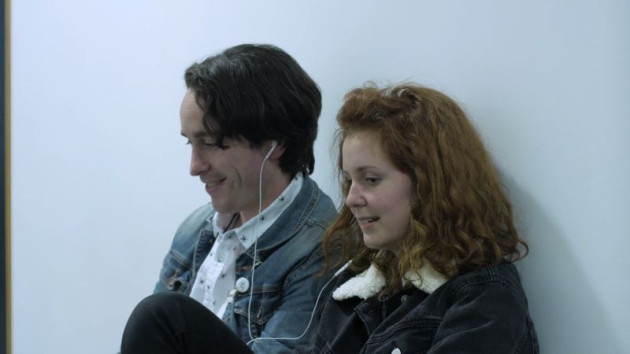
Adrian (Cilléin McEvoy) and Jodie (MartinaBabišová) share a quiet moment (photo source, Chiara Viale)
OS: Can you talk about the casting process? How did you find these actors, and why these actors?
CV: I tend to get to casting with a crystal clear sense of what I am looking for. This is based partly on looks, but mostly on feeling. I know exactly how a character must feel, what they must communicate, what kind of inner world belongs to them. Although during auditions I am ready to be surprised or presented with a performance I didn’t expect, what makes the difference for me is feeling that they understood the role, that they emotionally picked up the essence of the character I created. I was also looking for a main cast who would work together as a group, actors who would look and feel like a real punk band. I wished to create an ensemble with specific dynamics in which to insert the character of Adrian, first as an external element, but later as an essential part.
I already knew Patrick O’Brien from previous projects and I really loved his energy. I felt he would be perfect to play David. All I needed to ask him was if he played the bass, which he luckily did! Casting Jodie was also a very smooth process. We put a casting call out and Martina Babišová, who had previously worked with Philip, got in touch with me to be considered for the role. When I met her, I knew straight away she was perfect. There was no need to even audition her, she became Jodie there and then.
Casting Will was perhaps the hardest part of the process as we actually auditioned a number of actors. I was lucky to have the help of Sebastian Stephenson, who came on board as casting director and was also pivotal in the casting of Paula McGlinchey as Adrian’s Mother and Devlin O’Brien as Young Adrian. When Jack Fenton walked in, we had Cilléin, Patrick, and Martina sitting in the room waiting for him. We had chosen to go this way in order to immediately know how the actor would feel in the group dynamic. The audition scene had lines for everyone and Jack fit the character of Will like a glove. Physicality is one of the most important factors in Will’s personality. He is a character who is not afraid of fiercely taking up space. Will’s part in the script was dotted with pats on the back, hugs, and yawns, and during the audition Jack completely understood this at a gut level. As soon as he sat down, he was part of the band and the scene sang as if it was written for the actors in the room.
Other minor roles were cast among friends such as Aidan O’Sullivan (the Doctor), Fergus Keane (Jack), or the Homeless Man (Ciaran Farrell). Thanks to the Dublin Filmmakers Collective and Kino D, I had quite a network of actors and crew to contact, and I was delighted to have the opportunity to work with them.
OS: The character of Jodie (played by Martina Babišová) is eastern European. Was this because you had her in mind for the part, or was this character always going to be eastern European, and that’s why you cast her? This character can also be seen as a reference to Marketa Irglova in Once. Is that an intended reference or just a coincidence (after all, Dublin is full of non-Dubliners, such as yourself)?
CV: I find this question very interesting as I never before made any connection between the two characters, however the similarity is undeniable. Dublin is indeed full of non-Dubliners and whenever I write, I always end up crowding my narratives with people coming from all places. When it comes to The New Music, the only characters that needed to be Irish were Adrian and his mother, none of the nationalities of the other characters were really relevant. If the cast is predominantly Irish, this is because of the actors we found. Jack Fenton and Patrick O’Brien were simply the best possible Will and the best possible David, and the same applies to the rest of the cast. Although I had a perfectly clear idea of what the character of Jodie was going to be like, her nationality had always been irrelevant. What I was looking for was the attitude, the feeling and the energy for her to be the drummer of The Cellmates.

Jodie (Martina Babišová) on drums (photo source, Chiara Viale)
OS: Speaking of Once [John Carney, 2007], that and The Commitments [Alan Parker, 1991] are two very famous films about musicians in Dublin. Did you have them in mind while making The New Music, either as influences to emulate or, in a negative way, as things to avoid? In general, were there any other films that might have influenced you in the making of this film (again, in either positive or negative ways)?
CV: I really loved Once, and its visuals had an important impact on me. When I watched it for the first time, I was living in Germany and missing Dublin terribly (I would only move to live in Dublin a few years later, but I had visited Ireland many times and Dublin already held a big place in my heart). I think the film cemented itself in my imagination. It had that sense of a place I knew, of nostalgia, but also warmth and love. It also told a story that was very familiar to me in many ways and celebrated not the music of the big stages, but the songs sang quietly (or not so quietly) on the footpath of a busy Dublin street or music shop. I think The New Music has a similar familiarity to it, a simplicity and earnestness, a celebration of the small ordinary details that make life beautiful.
Strangely enough, I didn’t watch The Commitments until well after finishing The New Music. Obviously, everyone had told me to watch it many times, but somehow I only got around to it later. That affinity and parallelisms can be found between them is very humbling, as I absolutely adore The Commitments, but I am also delighted by the elements that make The New Music an entirely different film. I suppose that the lack of desire to “make it big” is also what differentiates it from Sing Street [John Carney, 2016], another Irish film that I have often seen it compared to. At the end of the day, The Cellmates is a band who plays together to have fun, to be themselves, to make sense of the world around them. It is exactly this celebration of life for what it is that helps Adrian accept himself again.
From this perspective, there are a number of films that influenced The New Music. Most of them are films I watched as a child, stories that had a big impact on me and that somehow made their way into the film without me being fully aware of it until after filming. Giuseppe Tornatore’s The Legend of 1900 [1998] is a film I watched countless times with my parents, unaware that I was listening to Ennio Morricone’s score and Alessandro Baricco’s words. My grandmother had a VHS of Shine [Scott Hicks, 1996], and I can’t recall how many times I watched Geoffrey Rush’s breathtaking performance. I also drew a lot from films such as Control [Anton Corbijn, 2007], Almost Famous [Cameron Crowe, 2000], Good Vibrations [Glenn Leyburn and Lisa Barros D’Sa, 2012], Le concert [Radu Mihăileanu, 2009], and Todd Haynes’s Velvet Goldmine [1998]. From a purely musical perspective, Pink Floyd – The Wall [Alan Parker, 1982] was the first piece of cinema I ever saw that shook me to the core with the sheer strength of association between music and visuals. Before that, I had no idea of just how striking a music video could be. I believe that is when I became conscious of the power of music in cinema and this knowledge never left me.
As I started to listen to punk music, I watched a number of music documentaries which heavily influenced me in the writing and making of The New Music, such as We Jam Econo: The Story of the Minutemen [Tim Irwin, 2005], Salad Days [Scott Crawford, 2014], and The Devil and Daniel Johnston [Jeff Feuerzig, 2005].
OS: More generally, how about films and filmmakers who have influenced how you look at and make films, and if you are conscious of examples of these influences turning up in The New Music?
CV: As I said, The New Music was profoundly influenced by a number of films which I had the privilege to watch at a young age. I have a very strong emotional memory and many music sequences and strong moments emphasized by the score or sound design are perfectly imprinted within me to this day. I often remember when and where I was when I saw those scenes for the first time, and the feeling never left me. I am sure that the imprint of these films is all over The New Music and will influence every film I will ever make.
I believe that this strong, almost overwhelming relationship I started to have with cinema at a young age might be why I always look for emotional connection in films, why I want to be shaken by them, to be changed. The films that influenced me the most are those that found a way inside and altered something within me that hasn’t been the same since. Andrei Tarkovsky’s work changed me, and so did Ingmar Bergman’s. Italian directors such as [Federico] Fellini, [Vittorio] De Sica, and [Pier Paolo] Pasolini have a strong influence on my work and never cease to light up my imagination. I am also endlessly moved and inspired by the work of Michael Haneke, Arnaud Desplechin, and Hirokazu Kore-eda.
OS: Did you have specific locations in mind when writing the script, or did you write the script and find locations after? If the second, were there any problems finding locations that matched your ideas?
CV: The majority of locations in the script had been purposefully left vague. This made it easy to adapt the scenes to the locations we were able to find. One specific location we were not able to film in was a concert hall where I had envisioned Adrian, the protagonist, playing the piano during the opening montage. Principal photography had already started and although we pushed filming that scene to the very end of production, we weren’t able to find a suitable location. The concert hall was therefore substituted at the last minute with a music room. Not finding the right place for that scene is one of the things I regret the most about the production, however, in Will’s words: “We are not perfect, right? Life isn’t perfect, nothing’s perfect.”
OS: One of the most visually striking aspects of the film is the use of posters. Could you talk about where you found them, the idea to use them in the film, and what they bring to the film in providing atmosphere, conveying an idea of Dublin, and in any other way?
CV: The posters serve multiple functions. To start with, plastering the walls with posters was fitting for the characters themselves and their intention to make their apartment feel like home. As punk rock fans, they would put up posters of their favourite bands, and we dressed the location accordingly. Every poster looks as if it was put up by the characters themselves, the edges are messy, the placing and angles awkward. The Cellmates’ kitchen was designed to reflect the band’s state of mind, their messy but wholesome lifestyle, their love for the bands they listen to, their banter, and their commitment to music.
We also used written messages hung in the kitchen to enrich the world of the story. For example, the curtains behind the sink are closed to hide yet another construction site and a message on them reads “(another) coffee chain opening soon.” The gentrification of Dublin is one of the encompassing aspects of The New Music, and these words underline the band’s social and political awareness of the city they live in.
OS: In a related question, your use of a series of shots including posters and images of Dublin in your transitions is very interesting. They seem to create a tone and comment on the action. Was this intentional? How do you think these transitions function in your film?
CV: The New Music was filmed in summer 2017 and Philip and I went almost straight into the editing room. As the first assembly of the film came together, we made a list of b-rolls and pick-up shots which we would only able to film the following year as it was now late winter. By the time we took the camera back on the streets of Dublin, many things had changed. Some construction sites had become buildings and some buildings were now construction sites. Furthermore, a number of locations, such as the music shop where the scene of Adrian playing the piano takes place, did not exist anymore. This made filming some pick-ups impossible but it also gave us scope to be creative and find new ways to connect the city with the story we had filmed.
Filming b-rolls in Dublin in summer 2018 was a very fun experience. We got a city map and highlighted the film’s location, plus a number of neighbourhoods and streets that we thought would be evocative. Philip and I then simply took off and filmed everything that sparked our interest. At the end of this process, we found ourselves with a large amount of footage and in the editing room we experimented putting shots in sequence, juxtaposing them with the characters’ state of mind, and using them as a commentary not only on the story, but on Dublin itself.
I think that one of the most creative uses of Dublin footage in the film is the commentary on the presence of construction sites, both visually and through sound design. We wanted to capture the centre of Dublin as it truly is, its gentrification and its current development ideology which leaves many people at the mercy of a progress that will most certainly forsake them.
Within the story of the film, we showed how this process affects the characters’ lives, especially Adrian, who arrives in Dublin looking for shelter and peace, but what he finds is scaffolding and noise. The apartment is literally closed in by construction and the world outside keeps knocking, imposing a hard truth over the dreams and aspirations of those living in it.
This aspect of Dublin ended up having consequences behind the camera as well. As I mentioned, not only did we find ourselves wrestling with those changes that had occurred to the city within a year of filming, but since the film’s release many more locations have disappeared forever. In a sense, by now The New Music is a trip down memory lane, a testament to venues and iconic places that now belong to the past, but that we were privileged enough to capture forever.
_630_356_90.jpg)
(photo source, Chiara Viale)
_630_359_90.jpg)
(photo source, Chiara Viale)
OS: There are several spontaneous-looking sequences of your main characters on the streets and in pubs. How were they shot? Was there much improvisation involved? Can you talk about editing these sequences?
CV: The film’s montage sequences were almost completely improvised by the cast. While locations were chosen in advance, we gave the actors as much freedom as possible to experiment with their characters and react to each other. We mostly let the camera run and followed the action looking for spontaneity and emotional truth. From a directing perspective the actors were given guidelines with regards to their state of mind and any particular details to bring into the improvisation, such as Adrian hiding more or less his symptoms or his closeness to Jodie.
The three main montage sequences underline specific turning points in the story. These sequences have the role of cementing Adrian’s relationship with the band as well as showing his process of slowly opening up and embracing their way of life. In the editing room we looked for key moments, happy accidents, shots that conveyed the specific feeling we needed for that moment in the story. In the film as a whole, these sequences of improvisation and music convey a sense of freedom, authenticity, defiance, and lust for life. This would have, of course, been impossible without the incredible soundtrack we were privileged to have at our disposal.
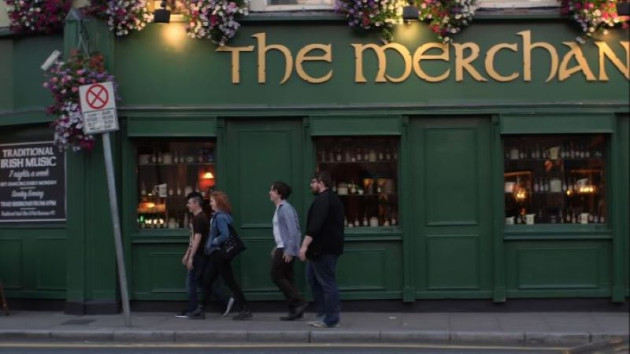
The Cellmates roam the streets of Dublin (photo source, Chiara Viale)
OS: Does being Italian give you a different perspective than Irish filmmakers when making a film in Dublin?
CV: It is impossible for me to pinpoint with accuracy how my approach differs from an Irish filmmaker. I have however been told many times that my perspective is indeed different and I think this is undoubtedly true. I suppose that a better understanding of this aspect of my work will come with time, but for now what I know is that I look at Dublin through my own eyes and sense of reality. I love this city from the perspective of someone who came to Dublin looking for a home and found it within its streets, shops, pubs, and atmosphere.
In The New Music, I filmed the city I love and I think this sometimes had the effect of showing people parts of Dublin they had not paid attention to in some time. Without having the clear intention to do so, I think I infected the film’s style and tone with my own relationship to the city. I have been told a few times by audience members that watching the film made them want to go back to Dublin, since I remember having the same reaction watching Once, I consider this one of the best compliments the film can receive.
OS: What are the benefits and difficulties that come with being an independent filmmaker in Dublin, as opposed to London or Italy?
CV: I am not acquainted with the the industry in Italy or the UK, as I only started working professionally in film once I came to Ireland. One undoubted benefit of making films in Dublin is that the filmmaking community is not very big and usually there are no more than two or three degrees of separation between you and any other name in the industry. Forging strong professional bonds is easy and so is making connections and friends. On the other hand, everyone knows everyone and your reputation will always precede you. Although this small town environment might feel a bit tight, I am in love with it. There is so much talent in Ireland, so much love for the arts. The New Music was only possible because of Dublin’s creative scene, its fancy for a bit of craziness, and its huge, wonderful heart.
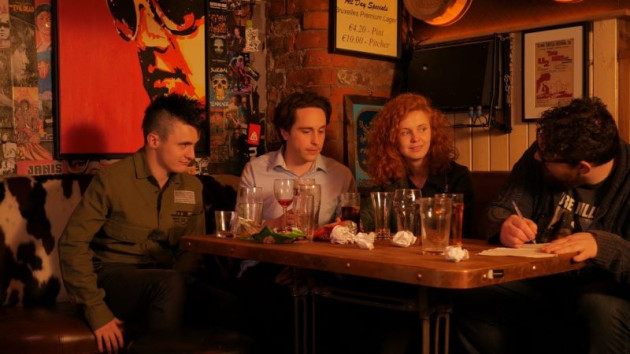
David (Patrick O’Brien), Adrian (Cilléin McEvoy), Jodie (MartinaBabišová), and Will (Jack Fenton) go for a few drinks (photo source, Chiara Viale)
OS: Can you talk about Dublin’s film scene? Is it an actual scene where filmmakers know each other and work on each other’s projects? Other than your own work, what recent Irish films would you recommend checking out?
CV: There are a few spaces in Dublin for filmmakers to get to know each other, network, and collaborate. One of the most interesting is Kino D, the Dublin branch of the International Kino Kabaret movement which was brought to Dublin for the first time ten years ago. Kino events in Ireland are one of the best opportunities for filmmakers to meet, pitch their short films, work on each other’s projects and sometimes start long lasting collaborations. My best example of this is that Philip Kidd and I met at Kino D in 2016. You can easily say The New Music wouldn’t exist without Kino D.
Other resources are filmmaking groups that operate in a similar way to the Dublin Filmmakers Collective. In my experience, these channels are a great way to create a network of people you work well with. The collaborative aspect of the films released in these contexts fosters a sense of fellowship, of wanting everyone around you to succeed. I still work with many of the people I met in these events and groups both on low budget and higher budget productions. There are many incredible filmmakers and beautiful works coming out of Ireland right now. Three films that I would highly recommend are Dean Kavanagh’s extraordinary film Hole in the Head [2022], Frank Berry’s latest feature Aisha [2022], and Luke McManus’ Dublin music documentary North Circular [2022].
OS: After making short films, you have now made your first feature. Was this always the plan? What are the main differences between making shorts and features? Beyond commercial considerations, what are the advantages and disadvantages of making a feature?
CV: A short film is a quick form of communication. It focuses on one idea, one concept and is meant to leave the audience deeply moved and wanting more of your work. I wrote long stories since I was a child and I started writing features as soon as I took on screenwriting. A feature is a completely different world. It permits much deeper, wider exploration. Although I still write and intend to make short films, the feature length is my favourite way of telling a story. Obviously feature films are much more onerous to make, and not only in a monetary sense. They require more time, more effort, and take on a much higher amount of risk. They stay with you for a lot longer and define your filmmaking career in a completely different way. They can open doors, but also close them. They are subjected to a much higher amount of criticism and you are much more likely to be tougher with yourself looking back at their flaws. In the case of The New Music, I was highly conscious of having been trusted with a huge amount of people’s time and resources. As the film progressed to the screen, I was responsible for the hopes, aspirations, and wishes of everyone involved. I wanted to make a film that would make each and everyone proud to have been part of it. This is a huge responsibility, but one I took gladly. I believe that as a director I am carrying the vision of my films, both the one that is received by the audience and the one cast and crew projected into it. A feature film is a shrine of dreams and I am privileged to be responsible for their realization.
OS: What are the advantages (if any) of low budget filmmaking? Does it force you to be more creative? What are the disadvantages?
CV: Low budget filmmaking allows for a large amount of flexibility and resilience. I was able to make a film with my friends, cast anyone I felt was right for the role, and freely make changes when necessary. When we embarked on The New Music, we were trying something new. We didn’t know if we would have a film by the end of our journey. We wanted to experiment, to challenge ourselves, to push our limits. This freedom would have been impossible if we were working with a more significant budget, if we had specific deadlines to meet, and if Philip and I had to answer to anyone but ourselves and Young Parkinson’s Ireland for our creative decisions.
The disadvantages are, of course, many, from not being able at times to book locations to juggling with the cast and crew’s availability. We worked with as minimal a crew as possible, which meant that Philip and myself had to wear many hats. As well as directing, I was responsible for most continuity and costumes. We did not have a set designer or art department, so Philip and I took on dressing the set and carrying props. However, we were hugely helped by the rest of the crew and the cast themselves. This is one of the best things about low budget: everyone was essential for the scene to work. There were no closed departments, no divisions, everyone was there to make a film together. If The New Music ended up being what we hoped, this is thanks to every single person on set.
OS: How has your film been distributed? How would an interested reader watch it?
CV: The New Music was picked up for worldwide sales by Silver Mountain Distribution after winning the Spirit Of IndieCork Award in 2019. The film is currently distributed by 101 films and available on Video On Demand in Ireland and UK. We are hoping for the film to travel further and become available in more countries soon.
OS: Did you study film? How did you decide to become a filmmaker?
CV: Although I always adored cinema, I never studied film. As a child, I wanted to be a writer and looking back, I can see I was very strongly oriented towards expressing myself visually even though I was rubbish at drawing and completely removed from filmmaking. I loved taking photos with the still camera I was given as a communion gift, but I just could not make a connection between my stories and the craft of cinema. I grew up extremely shy and insecure, constantly finding it hard to justify expressing my feelings artistically. Even when I started getting in touch with filmmaking, I didn’t feel entitled to direct a film and I was convinced I had to be able to operate a camera before I could even think of making cinema. What made the difference was starting to work with the Dublin Filmmaker’s Collective in 2015. Thanks to this community, I overcame my shyness and when I was asked to direct for the first time, I realized this is what I had wished to do all along. I have never looked back since.
OS: Do you have a new project in mind?
CV: I can’t wait to move to my second feature and I am currently working on a number of very interesting projects. In 2020, Cilléin McEvoy and I incorporated the production company Built To Fail Productions, under which we are developing 11 Ragman Street, a feature social drama influenced by Neo-realism and the British New Wave. This film is again very personal, a love letter to Dublin that revolves around the theme of family, memory, and legacy. Updates and news on 11 Ragman Street can be found on the website www.builttofailproductions.com.
I am also currently writing my first sci-fi feature screenplay, Phase 2, and adapting for the screen one of my unpublished novels, Lily & Ziggy.
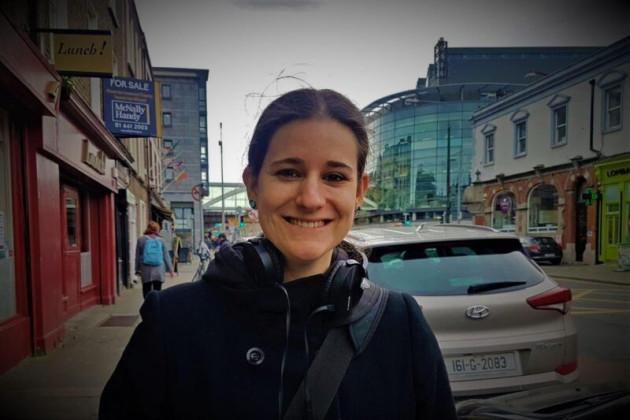
Chiara Viale (photo source, Chiara Viale)
All images from The New Music were supplied by Ms. Viale and are used with permission.

